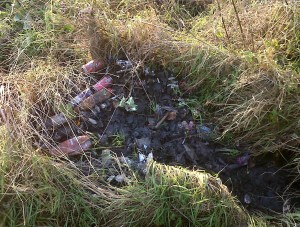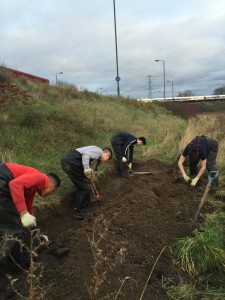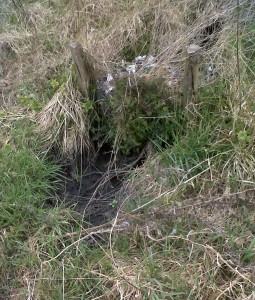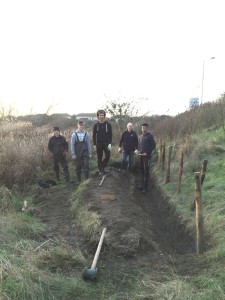As part of an ongoing collaboration with Thames21, the group managing Thames Road Wetland, four pupils from Crayford Academy came down on January 20th and helped complete the groundwork designed to keep vehicle oil out of the main waterbody at the site. They were supervised by volunteer Ray and new T21 staff member Joanna Barton. Another pupil was on hand to take photographs of the operation for a future presentation to other students.
Although the wetland has been said by a Council Officer to be a ‘Sustainable Urban Drainage’ system, and it is a superbly constructed site from the point of view of wildlife occupancy, road run-off was simply piped straight onto the site at the foot of the road embankment – apparently with no consideration whatsoever having been given to trapping rubbish and chemical pollutants, which is lamentable given that it was created as recently as 2007 and is within a Metropolitan Site of Importance for Nature Conservation boundary.
T21 put a basic litter trap in place around the outflow of the pipe a few years ago, using fine mesh chicken wire supported by stakes. The layer of litter (mainly plastic bottles, plastic wrapping, polystyrene fragments and beer cans) traps and holds back some of the oil, but in heavy rain it just washes out over the top and gradually runs down into the water despite a further obstacle in the form of a small bund.

The Mark 1 litter trap has captured almost all of the run-off litter, but not all of the oil. (Photo: Chris Rose)
Following advice from a T21 SUDS expert, and given the fairly short distance between the pipe mouth and the waterbody, pupils have spent much of their last two work sessions at the site digging a trench sideways along the bottom of the bank and making a large bund on the standing water side, using the excavated spoil. This has been hard going because of the compacted gravelly nature of the soil, which is still predominantly road embankment material at this point.

Crayford Academy pupils hard at work on the trench which, once planted up, is designed to intercept all oil residue washed off Thames Road and prevent it getting into the waterbody.
Next month some Sedges, currently growing in certain pathways where they hinder access, will be transplanted into the trench to help biologically filter and process the hydrocarbons (a process known as phytoremediation). We are referring to this as our ‘pre-SUDS’ facility, designed to continue keeping material such plastics, that cannot readily be processed by the biological systems onsite out, whilst drastically reducing the ingress of pollutants that can be, leaving the wetland to principally ‘manage’ the volume of water and not what’s in it. Meantime, there is a slick of oil along the bottom of the trench, but none has overtopped it despite recent rainfall, so it looks like it will work as intended. There is still the possibility that some oil residue will leak sideways and downhill towards the water, but the amount getting in there should be hugely reduced.
Chris Rose. TRW Volunteer Site Manager.


